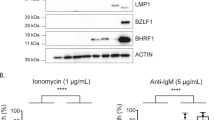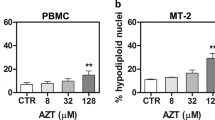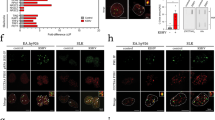Abstract
Kaposi’s Sarcoma Herpesvirus (KSHV) is the causative agent of Kaposi’s Sarcoma (KS) and two rare lymphoproliferative disorders, primary effusion lymphoma (PEL) and the plasmablastic variant of multicentric Castleman’s disease (MCD). The KSHV latency-associated nuclear antigen-1 (LANA), required for the replication and maintenance of latent viral episomal DNA, is involved in the transcriptional regulation of viral and cellular genes and interacts with different cellular proteins, including the tumour suppressor p53. Here, we report that LANA also recruits the p53-related nuclear transcription factor p73, which influences cellular processes like DNA damage response, cell cycle progression and apoptosis. Both the full-length isoform TAp73α, as well as its dominant negative regulator ΔNp73α, interact with LANA. LANA affects TAp73α stability and sub-nuclear localisation, as well as TAp73α-mediated transcriptional activation of target genes. We observed that the small-molecule inhibitor Nutlin-3, which disrupts the interaction of p53 and p73 with MDM2, induces apoptotic cell death in p53 wild-type, as well as p53-mutant PEL cell lines, suggesting a possible involvement of p73. The small-molecule RETRA, which activates p73 in the context of mutant p53, leads to the induction of apoptosis in p53-mutant PEL cell lines. RNAi-mediated knockdown of p73 confirmed that these effects depend on the presence of the p73 protein. Furthermore, both Nutlin-3 and RETRA disrupt the LANA–p73 interaction in different PEL cell lines. These results suggest that LANA modulates p73 function and that the LANA–p73 interaction may represent a therapeutic target to interfere with the survival of latently KSHV-infected cells.
This is a preview of subscription content, access via your institution
Access options
Subscribe to this journal
Receive 50 print issues and online access
$259.00 per year
only $5.18 per issue
Buy this article
- Purchase on Springer Link
- Instant access to full article PDF
Prices may be subject to local taxes which are calculated during checkout







Similar content being viewed by others
References
Chang Y, Cesarman E, Pessin MS, Lee F, Culpepper J, Knowles DM et al. Identification of herpesvirus-like DNA sequences in AIDS-associated Kaposi’s sarcoma. Science 1994; 266: 1865–1869.
Cesarman E, Chang Y, Moore PS, Said JW, Knowles DM . Kaposi’s sarcoma-associated herpesvirus-like DNA sequences in AIDS-related body-cavity-based lymphomas. N Engl J Med 1995; 332: 1186–1191.
Soulier J, Grollet L, Oksenhendler E, Cacoub P, Cazals-Hatem D, Babinet P et al. Kaposi’s sarcoma-associated herpesvirus-like DNA sequences in multicentric Castleman’s disease. Blood 1995; 86: 1276–1280.
Wang L, Damania B . Kaposi’s sarcoma-associated herpesvirus confers a survival advantage to endothelial cells. Cancer Res 2008; 68: 4640–4648.
Pan H, Zhou F, Gao SJ . Kaposi’s sarcoma-associated herpesvirus induction of chromosome instability in primary human endothelial cells. Cancer Res 2004; 64: 4064–4068.
Kliche S, Kremmer E, Hammerschmidt W, Koszinowski U, Haas J . Persistent infection of Epstein-Barr virus-positive B lymphocytes by human herpesvirus 8. J Virol 1998; 72: 8143–8149.
Guasparri I, Keller SA, Cesarman EKSHV . vFLIP is essential for the survival of infected lymphoma cells. J Exp Med 2004; 199: 993–1003.
Godfrey A, Anderson J, Papanastasiou A, Takeuchi Y, Boshoff C . Inhibiting primary effusion lymphoma by lentiviral vectors encoding short hairpin RNA. Blood 2005; 105: 2510–2518.
Wies E, Mori Y, Hahn A, Kremmer E, Sturzl M, Fleckenstein B et al. The viral interferon-regulatory factor-3 is required for the survival of KSHV-infected primary effusion lymphoma cells. Blood 2008; 111: 320–327.
Renne R, Barry C, Dittmer D, Compitello N, Brown PO, Ganem D . Modulation of cellular and viral gene expression by the latency-associated nuclear antigen of Kaposi’s sarcoma-associated herpesvirus. J Virol 2001; 75: 458–468.
An FQ, Compitello N, Horwitz E, Sramkoski M, Knudsen ES, Renne R . The latency-associated nuclear antigen of Kaposi’s sarcoma-associated herpesvirus modulates cellular gene expression and protects lymphoid cells from p16 INK4A-induced cell cycle arrest. J Biol Chem 2005; 280: 3862–3874.
Melino G, Lu X, Gasco M, Crook T, Knight RA . Functional regulation of p73 and p63: development and cancer. Trends Biochem Sci 2003; 28: 663–670.
Moll UM, Slade N . p63 and p73: roles in development and tumor formation. Mol Cancer Res 2004; 2: 371–386.
Grob TJ, Novak U, Maisse C, Barcaroli D, Luthi AU, Pirnia F et al. Human delta Np73 regulates a dominant negative feedback loop for TAp73 and p53. Cell Death Differ 2001; 8: 1213–1223.
Oliner JD, Pietenpol JA, Thiagalingam S, Gyuris J, Kinzler KW, Vogelstein B . Oncoprotein MDM2 conceals the activation domain of tumour suppressor p53. Nature 1993; 362: 857–860.
Haupt Y, Maya R, Kazaz A, Oren M . Mdm2 promotes the rapid degradation of p53. Nature 1997; 387: 296–299.
Honda R, Tanaka H, Yasuda H . Oncoprotein MDM2 is a ubiquitin ligase E3 for tumor suppressor p53. FEBS Lett 1997; 420: 25–27.
Kubbutat MH, Jones SN, Vousden KH . Regulation of p53 stability by Mdm2. Nature 1997; 387: 299–303.
Zeng X, Chen L, Jost CA, Maya R, Keller D, Wang X et al. MDM2 suppresses p73 function without promoting p73 degradation. Mol Cell Biol 1999; 19: 3257–3266.
Marin MC, Jost CA, Irwin MS, DeCaprio JA, Caput D, Kaelin WG . Viral oncoproteins discriminate between p53 and the p53 homolog p73. Mol Cell Biol 1998; 18: 6316–6324.
Roth J, Konig C, Wienzek S, Weigel S, Ristea S, Dobbelstein M . Inactivation of p53 but not p73 by adenovirus type 5 E1B 55-kilodalton and E4 34-kilodalton oncoproteins. J Virol 1998; 72: 8510–8516.
Steegenga WT, Shvarts A, Riteco N, Bos JL, Jochemsen AG . Distinct regulation of p53 and p73 activity by adenovirus E1A, E1B, and E4orf6 proteins. Mol Cell Biol 1999; 19: 3885–3894.
Kaida A, Ariumi Y, Ueda Y, Lin JY, Hijikata M, Ikawa S et al. Functional impairment of p73 and p51, the p53-related proteins, by the human T-cell leukemia virus type 1 Tax oncoprotein. Oncogene 2000; 19: 827–830.
Park JS, Kim EJ, Lee JY, Sin HS, Namkoong SE, Um SJ . Functional inactivation of p73, a homolog of p53 tumor suppressor protein, by human papillomavirus E6 proteins. Int J Cancer 2001; 91: 822–827.
Accardi R, Dong W, Smet A, Cui R, Hautefeuille A, Gabet AS et al. Skin human papillomavirus type 38 alters p53 functions by accumulation of deltaNp73. EMBO Rep 2006; 7: 334–340.
Hollstein M, Sidransky D, Vogelstein B, Harris CC . p53 mutations in human cancers. Science 1991; 253: 49–53.
Nador RG, Cesarman E, Chadburn A, Dawson DB, Ansari MQ, Sald J et al. Primary effusion lymphoma: a distinct clinicopathologic entity associated with the Kaposi’s sarcoma-associated herpes virus. Blood 1996; 88: 645–656.
Katano H, Sato Y, Sata T . Expression of p53 and human herpesvirus-8 (HHV-8)-encoded latency-associated nuclear antigen with inhibition of apoptosis in HHV-8-associated malignancies. Cancer 2001; 92: 3076–3084.
Friborg J, Kong W, Hottiger MO, Nabel GJ . p53 inhibition by the LANA protein of KSHV protects against cell death. Nature 1999; 402: 889–894.
Si H, Robertson ES . Kaposi’s sarcoma-associated herpesvirus-encoded latency-associated nuclear antigen induces chromosomal instability through inhibition of p53 function. J Virol 2006; 80: 697–709.
Cai QL, Knight JS, Verma SC, Zald P, Robertson ES . EC5S ubiquitin complex is recruited by KSHV latent antigen LANA for degradation of the VHL and p53 tumor suppressors. PLoS Pathog 2006; 2: e116.
Petre CE, Sin SH, Dittmer DP . Functional p53 signaling in Kaposi’s sarcoma-associated herpesvirus lymphomas: implications for therapy. J Virol 2007; 81: 1912–1922.
Sarek G, Kurki S, Enback J, Iotzova G, Haas J, Laakkonen P et al. Reactivation of the p53 pathway as a treatment modality for KSHV-induced lymphomas. J Clin Invest 2007; 117: 1019–1028.
Chen W, Hilton IB, Staudt MR, Burd CE, Dittmer DP . Distinct p53, p53:LANA, and LANA complexes in Kaposi’s Sarcoma-associated Herpesvirus Lymphomas. J Virol 2010; 84: 3898–3908.
Santarelli R, Farina A, Granato M, Gonnella R, Raffa S, Leone L et al. Identification and characterization of the product encoded by ORF69 of Kaposi’s sarcoma-associated herpesvirus. J Virol 2008; 82: 4562–4572.
Ohsaki E, Suzuki T, Karayama M, Ueda K . Accumulation of LANA at nuclear matrix fraction is important for Kaposi’s sarcoma-associated herpesvirus replication in latency. Virus Res 2009; 139: 74–84.
Ben-Yehoyada M, Ben-Dor I, Shaul Y . c-Abl tyrosine kinase selectively regulates p73 nuclear matrix association. J Biol Chem 2003; 278: 34475–34482.
Vassilev LT, Vu BT, Graves B, Carvajal D, Podlaski F, Filipovic Z et al. In vivo activation of the p53 pathway by small-molecule antagonists of MDM2. Science 2004; 303: 844–848.
Lau LM, Nugent JK, Zhao X, Irwin MS . HDM2 antagonist Nutlin-3 disrupts p73-HDM2 binding and enhances p73 function. Oncogene 2008; 27: 997–1003.
Kravchenko JE, Ilyinskaya GV, Komarov PG, Agapova LS, Kochetkov DV, Strom E et al. Small-molecule RETRA suppresses mutant p53-bearing cancer cells through a p73-dependent salvage pathway. Proc Natl Acad Sci USA 2008; 105: 6302–6307.
Carbone A, Cilia AM, Gloghini A, Capello D, Fassone L, Perin T et al. Characterization of a novel HHV-8-positive cell line reveals implications for the pathogenesis and cell cycle control of primary effusion lymphoma. Leukemia 2000; 14: 1301–1309.
D’Amours D, Sallmann FR, Dixit VM, Poirier GG . Gain-of-function of poly(ADP-ribose) polymerase-1 upon cleavage by apoptotic proteases: implications for apoptosis. J Cell Sci 2001; 114: 3771–3778.
Wong LY, Matchett GA, Wilson AC . Transcriptional activation by the Kaposi’s sarcoma-associated herpesvirus latency-associated nuclear antigen is facilitated by an N-terminal chromatin-binding motif. J Virol 2004; 78: 10074–10085.
Gwack Y, Hwang S, Byun H, Lim C, Kim JW, Choi EJ et al. Kaposi’s sarcoma-associated herpesvirus open reading frame 50 represses p53-induced transcriptional activity and apoptosis. J Virol 2001; 75: 6245–6248.
Seo T, Park J, Lee D, Hwang SG, Choe J . Viral interferon regulatory factor 1 of Kaposi’s sarcoma-associated herpesvirus binds to p53 and represses p53-dependent transcription and apoptosis. J Virol 2001; 75: 6193–6198.
Rivas C, Thlick AE, Parravicini C, Moore PS, Chang Y . Kaposi’s sarcoma-associated herpesvirus LANA2 is a B-cell-specific latent viral protein that inhibits p53. J Virol 2001; 75: 429–438.
Park J, Seo T, Hwang S, Lee D, Gwack Y, Choe J . The K-bZIP protein from Kaposi’s sarcoma-associated herpesvirus interacts with p53 and represses its transcriptional activity. J Virol 2000; 74: 11977–11982.
Tomasini R, Tsuchihara K, Wilhelm M, Fujitani M, Rufini A, Cheung CC et al. TAp73 knockout shows genomic instability with infertility and tumor suppressor functions. Genes Dev 2008; 22: 2677–2691.
Rosenbluth JM, Pietenpol JA . The jury is in: p73 is a tumor suppressor after all. Genes Dev 2008; 22: 2591–2595.
Toh WH, Nam SY, Sabapathy K . An essential role for p73 in regulating mitotic cell death. Cell Death Differ 2010; 17: 787–800.
Busuttil V, Droin N, McCormick L, Bernassola F, Candi E, Melino G et al. NF-kappaB inhibits T-cell activation-induced, p73-dependent cell death by induction of MDM2. Proc Natl Acad Sci USA 2010; 107: 18061–18066.
Amin AR, Paul RK, Thakur VS, Agarwal ML . A novel role for p73 in the regulation of Akt-Foxo1a-Bim signaling and apoptosis induced by the plant lectin, Concanavalin A. Cancer Res 2007; 67: 5617–5621.
Sarek G, Ma L, Enbäck J, Järviluoma A, Moreau P, Haas J et al. Kaposi‘s sarcoma herpesvirus lytic replication compromises apoptotic response to p53 reactivation in virus-induced lymphomas. Oncogene 2013; 32: 1091–1098.
Viejo-Borbolla A, Kati E, Sheldon JA, Nathan K, Mattsson K, Szekely L et al. A domain in the C-terminal region of latency-associated nuclear antigen 1 of Kaposi’s sarcoma-associated Herpesvirus affects transcriptional activation and binding to nuclear heterochromatin. J Virol 2003; 77: 7093–7100.
Platt GM, Simpson GR, Mittnacht S, Schulz TF . Latent nuclear antigen of Kaposi’s sarcoma-associated herpesvirus interacts with RING3, a homolog of the Drosophila female sterile homeotic (fsh) gene. J Virol 1999; 73: 9789–9795.
Viejo-Borbolla A, Ottinger M, Bruning E, Burger A, Konig R, Kati E et al. Brd2/RING3 interacts with a chromatin-binding domain in the Kaposi’s Sarcoma-associated herpesvirus latency-associated nuclear antigen 1 (LANA-1) that is required for multiple functions of LANA-1. J Virol 2005; 79: 13618–13629.
Acknowledgements
We thank Magdalena Weidner-Glunde for cloning of the GST fusion construct LANA N, as well as Eva Gellermann for cloning the GST fusion constructs C8a and C8b. This work was supported by the DFG IRTG 1273, the EU Integrated Project INCA (LSHC-CT-18730) and the collaborative research centre (CRC) 900 of the Deutsche Forschungsgemeinschaft.
Author information
Authors and Affiliations
Corresponding author
Ethics declarations
Competing interests
The authors declare no conflict of interest.
Additional information
Supplementary Information accompanies the paper on the Oncogene website
Rights and permissions
About this article
Cite this article
Santag, S., Jäger, W., Karsten, C. et al. Recruitment of the tumour suppressor protein p73 by Kaposi’s Sarcoma Herpesvirus latent nuclear antigen contributes to the survival of primary effusion lymphoma cells. Oncogene 32, 3676–3685 (2013). https://doi.org/10.1038/onc.2012.385
Received:
Revised:
Accepted:
Published:
Issue Date:
DOI: https://doi.org/10.1038/onc.2012.385
Keywords
This article is cited by
-
Gene essentiality landscape and druggable oncogenic dependencies in herpesviral primary effusion lymphoma
Nature Communications (2018)
-
Antimicrobial sulfonamides clear latent Kaposi sarcoma herpesvirus infection and impair MDM2–p53 complex formation
The Journal of Antibiotics (2017)



